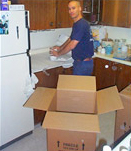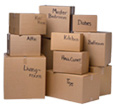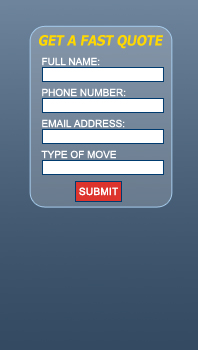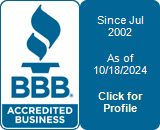At us Van Lines, Customer Satisfaction is Our #1 Goal
![]()
To Pack Or Not To Pack - That is the Question?
Choosing to pack yourself, you need to be aware of a few things. There are a lot of advantages as well as disadvantages to consider. First, what are your priorities? Do you have the time and the patience to go through and properly pack your household items? Will memory lane bog you down; not knowing how to properly pack something halt the process? This is the big decision that should be thought out clearly and planned properly.
Packing Yourself
This is always the best option since you are able to finally throw out those items you have been longings to go through. This also allows you the time to properly separate your belongings so as to how you would want them to be when you do begin your unpacking. And, lastly packing yourself helps you get a better idea of what you really want and really need for your new home.
Packing Materials
By doing your own packing you are also able to save money by using your own materials. A good idea is to check out stores that discard choice cardboard boxes. As movers we will be happy to offer you moving boxes which we will deliver at no additional charge. Keep in mind that the best way to keep your moving cost low is to try to do the packing yourself and finding supermarket boxes.
Packing Guidelines
If you decide to do at least some of the packing yourself, then you will need to have everything properly packed and ready for loading when the moving van arrives. All packing must be completed by the evening before moving day. Only the things you'll need that night, the next morning, and immediately at your destination should be left for last-minute packing.
Labeling Hints
Each and every carton should be labeled to help identify where you would like the boxes to be placed upon reaching your destination. Some recommended tips are:
- Use a broad, felt-tipped marker.
- Clearly mark room and contents.
- Indicate "FRAGILE" on delicates; "THIS END UP" where appropriate.
Getting Started
 Before packing cartons, you'll need to wrap most items to protect them from scratching and breakage. There are a variety of materials available to you including bubble wrap, foam peanuts, and tissue. However, most professionals use bundles of clean, unprinted newsprint (available at US Vanlines).
Before packing cartons, you'll need to wrap most items to protect them from scratching and breakage. There are a variety of materials available to you including bubble wrap, foam peanuts, and tissue. However, most professionals use bundles of clean, unprinted newsprint (available at US Vanlines).
Start by placing a small stack of paper on a flat, uncluttered table or countertop. Round glasses and jars can be rolled up in two or three sheets of paper; always begin from a corner of the sheet and fold the sides in as you roll.
Large or odd-shaped items require a similar technique. Place them in the center of the sheet and bring the corners together. It may be necessary to flip the item over and wrap it again from the other side. If in doubt, use more paper!
Before packing each carton, line the bottom with a few scrunched up pieces of newsprint paper for padding. Then place large, heavy items on the bottom and lighter, more fragile items on the top.
Plates, books and things of a similar shape, should be loaded vertically to utilize their own maximum structural strength. Don't overload cartons; keep them to a manageable weight. Fill in any voids and top off loaded cartons with wadded paper. Then tape cartons securely to avoid shifting while en route.
We always recommend having moving professionals handle each and every aspect of the packing so as to ensure that items are properly and professionally secured in corrugated cartons. You won't believe the peace of mind you will have, knowing that your precious contents are properly prepared and managed.
Tips From the Pros
- Drawers need to be emptied to maintain the safe transport of the furniture piece. This protects the furniture from possible damage en route.
- Pack similar items together. This will maintain the sturdiness of the box as well as help you in the unpacking.
- Wrap items individually in clean newsprint (white) paper for fine china, crystal and delicate items. Colored wrapping paper as well as inked newspaper will cause the color to transfer onto your china and will not come out.
- Place a two- or three-inch layer of crushed paper in the bottom of cartons for safe cushioning.
- Build up the layers, with the heaviest things on the bottom, medium weight next and lightest on top.
- As each layer is completed, fill in empty spaces firmly with crushed paper and add more crushed paper to make a level base for the next layer, or use sheets of cardboard cut from cartons as dividers.
- Cushion well with crushed paper; towels and lightweight blankets may also be used for padding and cushioning. The more fragile the item, the more cushioning needed. Be sure no sharp points, edges or rims are left uncovered.
- Pack small, fragile, individually wrapped items separately or a few together in small boxes, cushioning with crushed or shredded paper. Place small boxes in a single large box, filling in spaces with crushed paper.
- Avoid overloading cartons, but strive for a firm pack that will prevent items from shifting; the cover should close easily without force, but should not bend inward.
- Seal cartons tightly with tape and place to the side for the moving day.
- As you finish with each carton, list the contents on the side of the carton (for your reference). You might want to number and/or code the cartons as well.
- Indicate your name and the room to which each carton should be delivered at destination. Another good tip is to tape a sign on the door of each room at destination corresponding to the carton labels so movers can get the cartons into the proper rooms quickly. This is optional however.
Corrugated Boxes List & Description
Dish Pack (or China Barrel)
Extra sturdy corrugated carton of double-wall construction for all breakables such as china and dishes, crystal and glassware. Also used for lamps, large flower arrangements etc.
Small (Book Carton) - 1.5 cubic foot carton
A small, easy to handle carton designed for heavy items such as books, records, tapes, dvds, small picture frames, and small appliances.
Medium - 3 cubic foot carton
Medium utility box often used for pots and pans, toys, non-perishable food, small appliances, lampshades, and clothes. This is the most popular box for moving day.
Large (Rectangular/ Lamp) - 6.0 cu. ft. carton
For lightweight bulky articles such as pillows, blankets, comforters, and any other large item that should be placed in a box.
Wardrobe Carton
This large carton has a hangar bar to accommodate clothes from your closet or draperies.
 Mirror Carton
Mirror Carton
Specific sized boxes to fit almost any picture, mirror or glass.
Mattress Carton / Mattress Bag
Available in king, queen, double, single (twin) and crib sizes; you'll need one for every box spring and every mattress. Keeps your mattresses hygienically clean.
Question: Am I covered for damage if I do my own packing?
The advantage of doing your own packing is cost savings, and having the opportunity to purge the things you no longer want. Movers, however, cannot be responsible for your packing skills. If there is no external damage to a container packed by its owner, there will be no liability for damage to the contents. The best suggestion is to consult with one of our representatives to find out more information about the appropriate coverage for you.
Question: How can I get boxes for packing myself?
We offer FREE BOX DELIVERY; we make boxes available to our customers who choose to do their own packing. If you would like boxes, and you live near one of our terminals, we offer delivery right to your home at no additional charge.
Question: How might I transport my plants?
There are some restrictions on transporting plants from state to state. We recommend you contact one of our sales representatives who can further assist you regarding this issue.
Fully Licensed and Insured
We are committed to consistently provide a high quality
of service unmatched by those of industry standards.
Copyright © 2009 US-VanLines.com | Term & Conditions
Headquarters: (800) 785-0067 Licenses: US DOT: 913954 - MC/ICC: 409524



